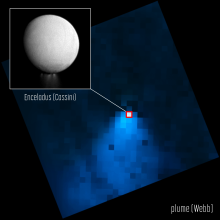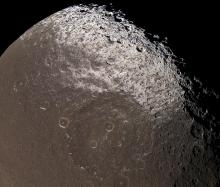Listen to today's episode of StarDate on the web the same day it airs in high-quality streaming audio without any extra ads or announcements. Choose a $8 one-month pass, or listen every day for a year for just $30.
You are here
Moon and Saturn
The jewels of the solar system may not have been in the family for long. Observations by the Cassini spacecraft suggest the rings of Saturn could have formed within the last couple of hundred million years.
For a long time, astronomers thought the rings formed at the same time as Saturn itself — about four and a half billion years ago. Over the last few decades, though, there have been indications that the rings are much younger.
The latest came during Cassini’s final months. By flying between Saturn and the inner edge of the rings, it found that the rings aren’t as massive as many had expected — there’s just not much to them. And it found that if the rings were very old, they should have been darkened by a steady “rain” of dust.
According to Cassini scientists, the fact that the rings are still quite bright means they could have formed as recently as a hundred million years ago. They could have been born when a passing comet or asteroid pulverized a small moon. Or the gravity of the Sun could have pushed two moons off track, causing them to ram together and destroying both of them.
Not everyone accepts the young age for the rings, though. So it probably will take a bit more study to solve the mystery of the age of Saturn’s rings.
Look for Saturn near the Moon the next couple of nights. It looks like a bright golden star to the left of the Moon tonight, and closer to the lower right of the Moon tomorrow night.
Script by Damond Benningfield






